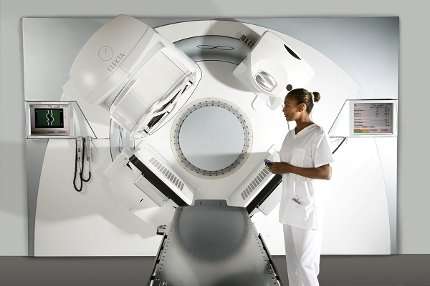- Home
- Editorial
- News
- Practice Guidelines
- Anesthesiology Guidelines
- Cancer Guidelines
- Cardiac Sciences Guidelines
- Critical Care Guidelines
- Dentistry Guidelines
- Dermatology Guidelines
- Diabetes and Endo Guidelines
- Diagnostics Guidelines
- ENT Guidelines
- Featured Practice Guidelines
- Gastroenterology Guidelines
- Geriatrics Guidelines
- Medicine Guidelines
- Nephrology Guidelines
- Neurosciences Guidelines
- Obs and Gynae Guidelines
- Ophthalmology Guidelines
- Orthopaedics Guidelines
- Paediatrics Guidelines
- Psychiatry Guidelines
- Pulmonology Guidelines
- Radiology Guidelines
- Surgery Guidelines
- Urology Guidelines
Magic MRI scan that offers quick and accurate detection of difficult knee injuries

Scientists at the Imperial College London have Developed a unique Magnetic Resonance Imaging (MRI) scanner which offers multiple orientations and hence may help detect difficult knee injuries more quickly, and more accurately.
The Magnetic Resonance Imaging can project a magnetic field to regions of the knee where conventional MRI fails to reach. This 'magic angle’ could potentially help diagnose knee injuries more quickly, and more accurately.
A study published in the journal Magnetic Resonance in Medicine has demonstrated that using the magic angle can accurately detect ligament and tendon damage.
Knee injuries commonly affect one of three areas: the tendons (which attach muscle to bone), the meniscus (a cushioning pad of cartilage that prevents the bones of the joints rubbing together), or the ligaments (tough bands of connective tissue that hold bones in a joint together).
“These structures are normally black on an MRI scan – they simply don’t produce many signals that can be detected by the machine to create the image. This is because they are made mostly of the protein collagen, arranged as fibres. The collagen fibres hold water molecules in a tight configuration, and it is in fact water that is detected by the MRI. If you do see a signal it suggests there is more fluid in the area – which suggests damage, but it is very difficult for medical staff to conclusively say if there is an injury.”
The small size of the device could enable it to be used in local clinics and even GP surgeries, potentially reducing NHS waiting times for Magnetic Resonance Imaging(MRI) scans.
Currently, key components of the knee joints such as ligaments and tendons are difficult to see in detail in the MRI scans, explains Dr Karyn Chappell, a researcher and radiographer from Imperial’s MSK Lab: “Knee injuries affect millions of people – and MRI scans are crucial to diagnosing the problem, leading to quick and effective treatment. However, we currently face two problems: connective tissue in the knee is unclear on MRI scans, and people are waiting a long time for a scan.”
Following a knee injury, a doctor may refer a patient for an MRI scan to help establish which part of the joint is injured. MRI scans use a combination of radio waves and strong magnets to ‘flip’ water molecules in the body. The water molecules send out a signal, which creates an image.
However, tendons, ligaments, and meniscus are not usually visible with MRI, due to the way water molecules are arranged in these structures, explains Dr Karyn Chappell.
To overcome this problem, Dr Chappell harnessed the power of a phenomenon called the ‘magic angle’: “The brightness of these tissues such as tendons and ligaments in MRI images strongly depends on the angle between the collagen fibers and the magnetic field of the scanner. If this angle is 55 degrees the image can be very bright, but for other angles, it is usually very dark.”
The team explains the magic angle is achieved in their scanner because they are able to easily change the orientation of the magnetic field. While the patient sits comfortably in a chair, the specially designed magnet (which uses motors and sensors similar to those found in robots in car factories) can rotate around the leg and the orientate magnetic field in multiple directions.
This is not possible in current hospital MRI scanners, which are also much more expensive than the prototype scanner.
In the study published in the journal Magnetic Resonance in Medicine, the multi-disciplinary team scanned the knee joints of six goats and ten dogs in a conventional MRI scanner.
All of the doglegs were donated by the Royal Veterinary College, having been donated for research by dog owners following the death of their pet.
Dogs suffer from knee injuries and arthritis similar to humans, making them a good subject for the study.
The results showed that using the magic angle can accurately detect ligament and tendon damage.
The team say now they know magic angle scanning can be used to visualize the knee, combining this with the new prototype mini scanner could enable knees to be accurately scanned with this technology – and hope to progress to human trials of the ‘mini’ scanner within a year.
Dr Chappell explained: “Although this is an early-stage proof-of-concept study, it shows the technology could potentially be used to accurately detect knee injury. We now hope to enter human trials – and explore if this technology could be used for other joints such as ankles, wrists, and elbows.”
For reference, please click on the link

Disclaimer: This site is primarily intended for healthcare professionals. Any content/information on this website does not replace the advice of medical and/or health professionals and should not be construed as medical/diagnostic advice/endorsement or prescription. Use of this site is subject to our terms of use, privacy policy, advertisement policy. © 2020 Minerva Medical Treatment Pvt Ltd